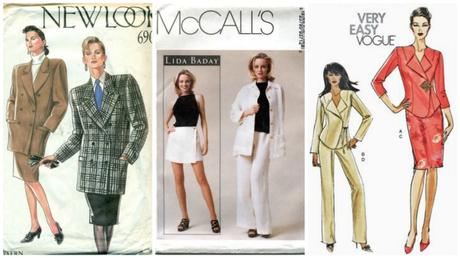In part 2 of this series on 6 brilliant strategies to creating the perfect wardrobe I'll be looking at three of the strategies you really need to consider, both for what you currently own in your wardrobe, plus things to consider before you make any new purchases to add to your closet.
What is the perfect wardrobe? Well, everything in it fits you (covered in part 1 which you can read here), and has the following qualities sorted too, read on ...

2. Quality
Is it good quality?
Quality is more than price. You need to consider the quality of the fabric and the construction as well as the fit (here I'm talking fit of the garment on your body). A high quality garment will look better and make you look higher quality (so if you're going for a promotion, this helps as it says you value yourself and others should too, and so they should pay you more!).
Fabric
Fabric is one of the key considerations to quality. A good quality fabric will last much longer and look better when worn. Fabrics made from acrylic (or any acrylic content) are just not worth the money. They pill really quickly and look worn and old so fast (I've seen jumpers/sweaters in my clients closet and when I've said that it looked old and worn they replied "but I've only had it for 3 weeks". Be warned!
Look for good quality fabrics, whether natural fibres like cotton (make sure the weave is closer together and from a finer thread), to wool (you want to look for merino wool as it has a longer fibre which won't pill quickly and also won't be scratchy like cheap wool with short fibres will be).
Construction
Is the garment well constructed? What do the seams look like? Is there top stitching? Does it look even and neat or shoddy? Are the hems hemmed with a blind hem (you can't see the sewing on the outside) or not? Are there threads hanging off? Are the buttons well attached? Is it lined? Are the seams all holding together or are they starting to unravel?
Consider all the elements of construction when purchasing a garment or deciding whether or not your current clothes need repair or is it time to let them go.
Good Shape
If it has been in your wardrobe for a while what is it's current condition? Does it look almost new or like you've been wearing it for some time? Is the colour fresh or faded? Is it pilled (you know those little balls that appear under your arms and on sleeves, anywhere that fabric rubs)?
Anything that looks past its prime, will make you look older, sloppy and give the message that you don't value yourself, or are lazy.
Discover more tips on quality here.3. Current or Modern
Unless you are vintage maven, I'd suggest that you want your wardrobe to look current and modern.
Looking youthful is very different to trying to look young.
Current means that you are not dated. That your ideas, outfits and life are not stuck in a time warp.
Old fashioned clothes = Old fashioned ideas Click To Tweet
In this fast paced, ever changing world in which we reside, particularly if you work for "the man" you need to be aware that communicating that you are keeping up with all this change is a very positive attribute (and yes I know it's super hard to do so!).
What's the difference between a fad, trend or classic?
There are fads that last a season or maybe two at most. They are generally not a shape or colour that is flattering to a wider portion of the population.
There are trends which last 2-5 years in fashion.
There are classics that last up to 10 years. But classics still change. The blazer shape of the 1980s was not the blazer of the 1990s nor is it the blazer shape today. Subtle changes sometimes, but still enough that draw attention to the age of the garments.

When you look at these jackets from the 1980s through the 1990s what do you notice changes? 1980s jackets were often double breasted, had huge shoulder pads and where low hip level and boxy in shape.
In the 1990s the shoulders were no longer padded but the longer length remained common and patch pockets were a frequent feature.
By 2010 the classic jacket of the day was shorter to around the high hip. Definitely fitted through the waist (even if it didn't have a peplum) and was most commonly single-breasted. So if you're not sure, read this post on Signs it's Time to Let it Go - which has a few more tips to help you decide.
I've mentioned fabric earlier today, but apart from natural fibres, any of the man-made fabrics will change over time. Early synthetics look very different to the synthetics of today. The fabric alone can date a garment and make it look out of fashion.
More tips on picking what is a fad vs a classic here.
4. Your Personality
Is it Still You?
When you look at garments that may have been favourites (which is why you're hanging onto them) please ask yourself "Is it still me?"
Is it you today or you from yesteryear? Click To Tweet
Sometimes we hold onto things for the memories, as if they will disappear if we no longer own the "thing" to which we attach them. Fortunately we do retain the memories, so you can let the garment go if it's no longer serving you in the way you want.
We all grow and change. Our personalities change over time. Just because we loved it at one time of our life doesn't mean we still have to love it the same way. If you look at a garment now, even if you've loved wearing it in the past, can you see yourself wearing it again today or tomorrow (weather and occasion permitting of course)?
You can also get into a habit of purchasing clothes like the ones you already own, and maybe they no longer really express who you are today? It's definitely worthwhile every few years revisiting who you are as a person and how you want to be perceived. What is the message you want to communicate to the world about who you are today? What are your values? How are you expressing the authentic you through the medium of your outfits and accessories? (This is something I cover in detail in my 7 Steps to Style program if you want some assistance with decoding clothing 😀 ).
Ideally your wardrobe is going to be full of only clothes that you love and love your right back.


